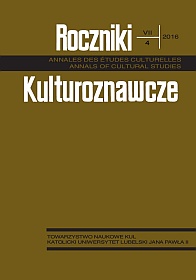The Relationship between Mathematics and Music
Abstract
Has music got something in common with mathematics? In this article the author deals with two expressions of culture belonging to its two disciplines: science and art. Mathematics belong to science, music to art. Music has always been and it will be the subject of profound research and exploration of its relationships with other domains. The aim of this article is to look at these two areas in the terms of mathematical relationships and similarities that can be found in music and to prove the thesis that the relationship between mathematics and music exist. While analyzing these two areas some facts are quoted that allow to prove this thesis. The author analyzes music compositions for deliberate use in their mathematical relationships, as well as songs in which mathematical structures can be seen in the works of composers who were not mathematicians.
Both areas are art forms that have their own alphabet or rather their own language of symbols. Mathematical studies teach to talk on extremely abstract mathematical problems in a strict and orderly way. Music is the most abstract and an ordered art form. And while mathematics is called “the queen of science,” so music could be called “the queen of art.” Thus, examining the relationship between these two manifestations of the culture we can understand and know each of them better.
References
„Allgemeine Musikalische Zeitung” 3:1801 (vom 1. Oct. 1800 bis 23. Sept. 1801). Leipzig: Breitkopf und Härtel Verlag.
Bohannon John: Riffs on Numerical Themes. „Science” 315:2007 Issue 26 (January 2007) s. 462-463. DOI: 10.1126/science.1139629.
Brożek Anna: Symetria w muzyce czyli O pierwiastku racjonalnym w komponowaniu dzieł muzycznych. Kraków–Tarnów: OBI–Biblos 2004.
Chang Chuan C.: Fundamentals of Piano Practice. [Charleston, SC]: Booksurge 2009.
Czarnecki Jan: Ineffable w filozofii muzyki. W: 10 Polski Zjazd Filozoficzny. Księga streszczeń. Red. Lidia Godek, Maciej Musiał, Marek Woszczek. Poznań: Wydawnictwo Naukowe Instytutu Filozofii UAM 2015 s. 222.
Da Vinci Leonardo: Traktat o malarstwie. Przeł. Maria Rzepińska. Gdańsk: Słowo/Obraz Terytoria 2006.
Dittrich Joanna: Filozofia muzyki Arystoksenosa. „Zeszyty Naukowe Towarzystwa Doktorantów UJ”, Nr specjalny 3 (2/2011), Kierunki badawcze w filozofii II.
Einstein Alfred: Mozart: Człowiek i dzieło. Przeł. Adam Rieger, Stefan Jarociński. Kraków: Polskie Wydawnictwo Muzyczne 1975.
Gołąb Maciej: Dodekafonia. Studia nad teorią i kompozycją pierwszej połowy XX wieku. Bydgoszcz: Pomorze 1987.
Gołaszewska Maria: Muzyka filozofii. Esej o podwójnych znaczeniach. „Muzyka” 2005, nr 1.
Grębski Tomasz: M jak Mozart i M jak Matematyka. „Matematyka” 2014 nr 11 s. 2-9.
Grębski Tomasz: Muzyka sfer. „Wiedza i Życie” 2014 nr 9 s. 54-59.
Grębski Tomasz: Usłyszeć geometrię i zobaczyć dźwięki. „Matematyka” 2014 nr 3 s. 6-12.
Guczalski Krzysztof: Formalizm w muzyce – przypadek Nicka Zangwilla. W: 10 Polski Zjazd Filozoficzny. Księga streszczeń. Red. Lidia Godek, Maciej Musiał, Marek Woszczek. Poznań: Wydawnictwo Naukowe Instytutu Filozofii UAM 2015 s. 229.
Harley James: Iannis Xenakis: Racjonalny mistyk, architekt dźwięku. „Muzyka” 43:1998 nr 4 s. 17-34.
http://encyklopedia.pwn.pl/haslo/matematyka;3938552.html
http://encyklopedia.pwn.pl/haslo/muzyka;3944813.html
http://www.azlyrics.com/lyrics/tool/lateralus.html
Hulse David: A fork in the road: an inspiring journey of how ancient solfeggio frequencies are empowering personal and planetary transformation! Bloomington, Ind.: Authorhouse 2009.
Isaacson Walter: Einstein His Life and Univers. New York: Simon & Schuster 2007. Przekład pol.: Einstein. Jego życie, jego wrzechświat. Przeł. Jarosław Skowroński. Warszawa: WAB 2014 (ebook).
Jarzębska Alicja: Strawiński: myśli i muzyka. Kraków: Musica Iagellonica 2002
Köchel Ludwig Ritter von: Chronologisch-thematisches Verzeichnis sämtlicher Tonwerke Wolfgang Amade Mozarts. Leipzig: Breitkopf & Härtel 1905.
Kordos Marek: Wykłady z historii matematyki. Warszawa: WSiP 1994.
„Kwadrat. Gazetka Olimpiady Matematycznej Gimnazjalistów” 2015 nr 15.
Moraczewski Krzysztof: Wewnętrzna historyczność sztuki. Przykład muzyki. W: 10 Polski Zjazd Filozoficzny. Księga streszczeń. Red. Lidia Godek, Maciej Musiał, Marek Woszczek. Poznań: Wydawnictwo Naukowe Instytutu Filozofii UAM 2015 s. 222.
Nantais Kristin M., Schellenberg E. Glenn: The Mozart Effect: An Artifact of Preference. „Psychological Science” 1999 nr 10 (4) s. 370-373.
Orman Edyta: Muzyka na tle innych sztuk w ujęciu Thrabsybulosa Georgiadesa W: 10 Polski Zjazd Filozoficzny. Księga streszczeń. Red. Lidia Godek, Maciej Musiał, Marek Woszczek. Poznań: Wydawnictwo Naukowe Instytutu Filozofii UAM 2015 s. 230.
Patel Aniruddh D., Iversen John R.: The linguistic benefits of musical abilities. „Trends in Cognitive Sciences” 2007 nr 11 s. 369-372.
Putz John F.: The Golden Section and the Piano Sonatas of Mozart. „Mathematics Magazine” 68:1995 No. 4 s. 275-282.
Root-Bernstein Robert Scott, Root-Bernstein Michèle: Sparks of Genius. The thirteen thinking tools of the world’s most creative people. New York–Boston: Houghton Mifflin Company 1999.
Roth Susan: Do Re Mi: If you can read music, Thank Guido D’Arezzo. Boston, Mass.: Houghton Mifflin Company 2006.
Stróżecka Elżbieta: Między matematyką, muzyką i filozofią. Teksty Konferencji MathPAD 2012, UMK, Toruń: 2012. https://mathcas.files.wordpress.com/2012/09/a11-strozecka_muzyka1.pdf
West Martin L.: Muzyka starożytnej Grecji. Przeł. Maciej Kaziński, Anna Maciejewska. Kraków: Homini 2003.
Xenakis Iannis: Debussy a sformalizowanie muzyki. „Ruch Muzyczny” 1962 nr 16 s. 7.
Xenakis Iannis: Formalized Music. Stuyvesant, NY: Pendragon 1992.
Zdanowicz Anna: Matematyka w Muzyce. http://www.msn.ap.siedlce.pl/smp/msn/36/zdan.pl





